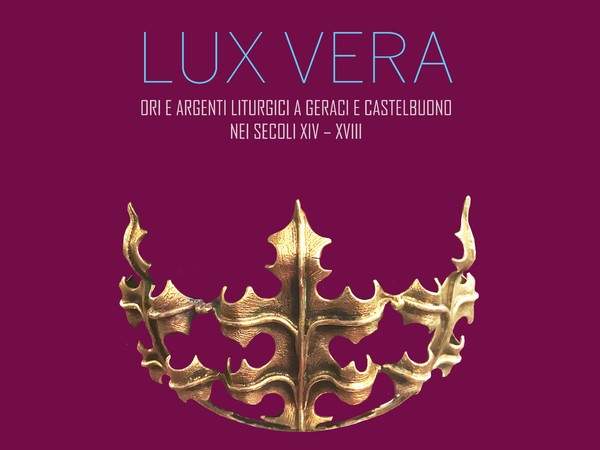The Civic Museum of Castelbuono (Palermo) is hosting the exhibition LUX VERA - Gold and liturgical silverware in Geraci and Castelbuono in the 14th - 18th centuries curated by Angela Sottile and Francesco Sapuppo (July 20, 2019 - January 26, 2020), produced in collaboration with the Ecclesiastical Museum Santa Maria Maggiore of Geraci Siculo and the Parish of the Nativity of the Virgin Mary of Castelbuono. The exhibition inaugurated in the period of the feast of St. Anne, patron saint of Castelbuono, is part of the cultural program that the Civic Museum dedicates to the religious celebrations on July 25, 26 and 27.
Curator Angela Sottile writes about the exhibition, “The Madonie territory is characterized by admirable natural beauty and the charm of its towns, located between the mountains and the sea and permeated with history and tradition. The artistic heritage preserved in the churches, palaces and streets of these centers is immense and precious and bears witness to a long and indivisible history that has forged men and traditions, works and knowledge. In 1937 the art historian Maria Accascina organized the first exhibition of Sacred Art of the Madonie, comparing for the first time works of art and objects of ’decorative’ art as the only expression of a creative vitality that has found ample affirmation in the Madonie. Certainly great impetus to artistic production in the Madonie territory is linked to the presence of a rich and avant-garde patronage, first and foremost that of the Ventimiglias, counts and then marquises of Geraci and princes of Castelbuono, one of the most influential families in medieval and Renaissance Sicily. Having settled in Geraci in the 13th century, the Ventimiglias moved their court to Castelbuono in 1454, to the castle of the same name that now houses the Civic Museum.”
The history of these two centers, Castelbuono and Geraci, close geographically and by historical experience, allows us to imagine, continues the curator, “a joint path carried out through the collaboration between the main museum institution of Castelbuono and the Ecclesiastical Museum Santa Maria Maggiore of Geraci Siculo, in the objective of building a moment of in-depth study on the common history of the two towns, outlined through the rich production of liturgical furnishings, of which great testimony is found within the two Museums. Two collections, those of Castelbuono and Geraci, which for the first time meet and intertwine in a joint path enriched by the precious furnishings of the Matrice Nuova of Castelbuono. Gold, silver, works of decorative art that are precious and delightful images of a living and tangible faith and refined art lent to devotion in which light is materialized essence, material manifestation of the divine, intangible place of the Absolute.”
The title, “Lux Vera,” refers to the description of Christ in the prologue of John’s Gospel as the light “which enlightens all.” And it is precisely light that is the guiding element of the exhibition project, reflected from the metal surfaces of monstrances, reliquaries and chalices and reverberated as a living, incorruptible soul, flowing through the embossed and chiseled forms in a very rich and varied artistic heritage that covers a very wide time span, ranging from the monstrance/reliquary by Piro di Martino da Pisa, from the 14th century, to the elaborate reliquaries and monstrances of the 18th century.
The rich collection of Sacred Art of the Civic Museum, kept in the rooms on the second floor of the Ventimiglia Castle, and coming precisely from the liturgical heritage of the adjoining Palatine Chapel dedicated to St. Anne, will host the goods from Geraci and those from the Madrice Nuova of Castelbuono in a joint itinerary developed within the display cases of the permanent layout and guided by textual, graphic and multimedia insights.
Finally, the exhibition itinerary is completed by a thematic focus dedicated to the Ventimiglian chapels of Sant’Anna that have housed throughout history the precious relic of the Sacred Skull: the first chapel, i.e., the small church of St. Anne, built within the castle walls of Geraci; the second, corresponding to the square-sectioned room on the second floor of the Ventimiglia castle of Castelbuono; and the third and last, i.e., the late 17th-century chapel decorated with Serpotta stuccoes on a pure gold background, located on the second floor of the same castle.
The Civic Museum offers the citizens of Castelbuono and Geraci a discounted entrance fee of Euro 2.00 for the entire exhibition period of the exhibition.
The exhibition project was realized thanks to the contribution of Irfis-FinSicilia spa.
For all information you can visit the museum’s official website.
Source: press release
 |
| Sicily, an exhibition dedicated to gold and liturgical silverware from Geraci and Castelbuono |
Warning: the translation into English of the original Italian article was created using automatic tools. We undertake to review all articles, but we do not guarantee the total absence of inaccuracies in the translation due to the program. You can find the original by clicking on the ITA button. If you find any mistake,please contact us.